Author and former bookshop owner Annemarie Florian tells us about three quite different recent releases, from New Zealand and further afield.
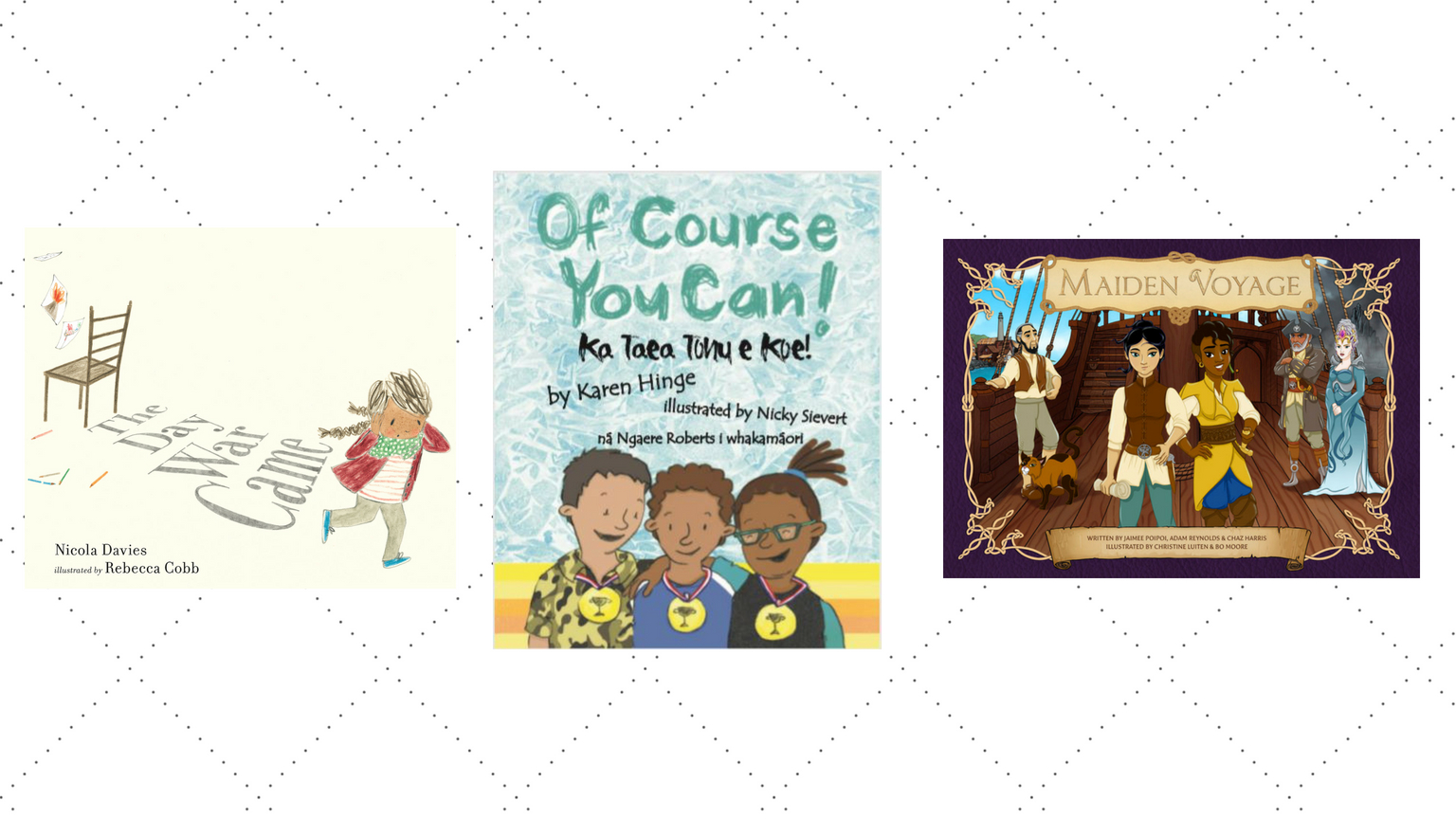
The Day War Came, by Nicola Davies, illustrated by Rebecca Cobb (Walker Books)
War – modern warfare – is a far cry from the images that sit in our adult collective memory from wars of the last century, conflicts which involved one country being invaded by another’s organized and identifiable military forces.
In this century and in this book, chaos, death and destruction, their source completely unidentifiable – war — appears from nowhere, on an ordinary day in an ordinary life and turns an ordinary town to rubble. Imagine that if you can.
Begin with the dedication: ‘to children who are lost and alone and to those who help them’. Move through the pages as one child’s ordinary life is inexplicably transformed into a lonely, hungry, dark and chaotic torment. Stark images sequence her journey away from that horror to a place of order, yet still a place without welcome. Read and absorb the spare and moving poem about this one lost and alone child, how war invades every part of her being and how just one message of hope, delivered through direct action, can begin to ‘push the war back’.
Walker Books have an enviable reputation for the children’s books they produce. Rightly so. They are brave publishers, prepared to tackle the hard questions faced by our society, and to partner with other organisations, in this case Amnesty International, to “shine a light on children’s rights to be safe and have an education”. They’ve ensured clever and thoughtful design that results in a small, strongly-felt glimpse into another’s reality.
They’ve ensured clever and thoughtful design that results in a small, strongly-felt glimpse into another’s reality.
A haunting, nightmarish reality conveyed by dark, muted images. Cobb’s naïve, hand-drawn illustrations appear as if coloured in by a child’s hand. Very effective, showing a child’s perspective, caught up in a completely senseless nightmare and the subsequent not-belonging it results in.
Nicola Davies is an experienced, gifted and prolific writer. With a background in zoology, her books are most often about animals and the natural world. This book had a different inception: she got angry. She got angry over her own government’s refusal to allow 3000 child refugees to enter her country. She got angry after hearing about a child refused entry to a school, for want of a chair to sit on.
Times like these, all of us need to get angry. All of us need to turn that anger into action, individual action, to bring a chair for another to sit on, to be kind. We all need reminding of that, and this book delivers a reminder both sage and insightful.
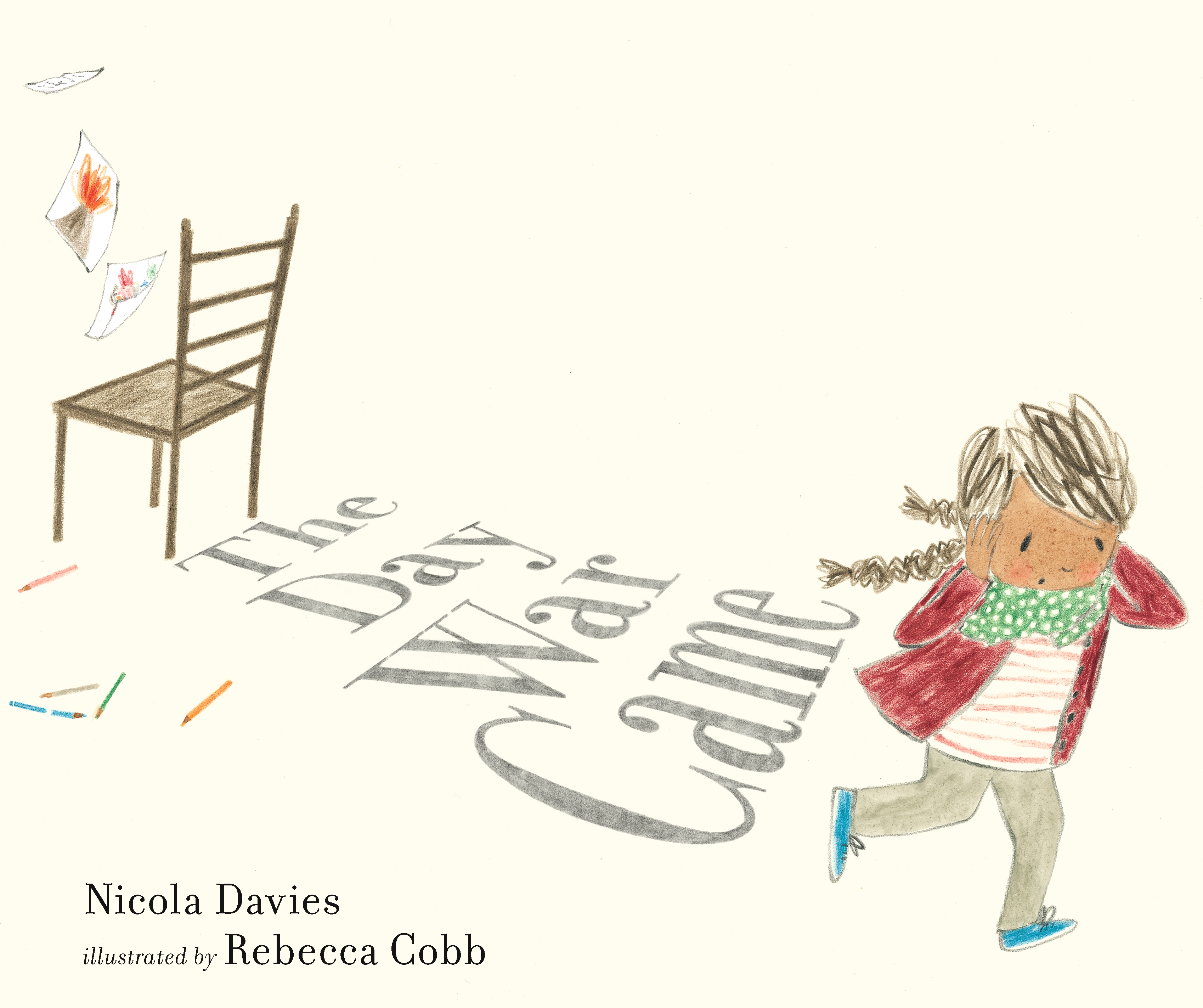
Of Course You Can! Ka Taea Tonu E Koe!, by Karen Hinge, nā Ngaere Roberts i whakamāori, illustrated by Nicky Sievert (OneTree House)
Awesome, a book about us – so many of us, children and adults who go to school and come home each day and live our lives honestly and generously, mixing and mingling and problem-solving without fuss or fanfare or overindulgence of anybody’s feelings or helicopter-parenting or preachy discussions about inclusiveness.
The day Jeremy’s mother drops him off at his new school, he’s none too sure about how he will fit in. But the other kids at Kowhai Street Primary have no such reservations. When Jeremy can’t reach the mat game on the floor or access the stage for Kapa Haka, quick and obvious solutions are found so he can. “Course you can,” say his classmates. He can be an excellent goalie when there’s a soccer game on, and cross-country is a breeze, laughing and socializing with your mates all the way. (After all, isn’t that how many endure and come to enjoy it?)
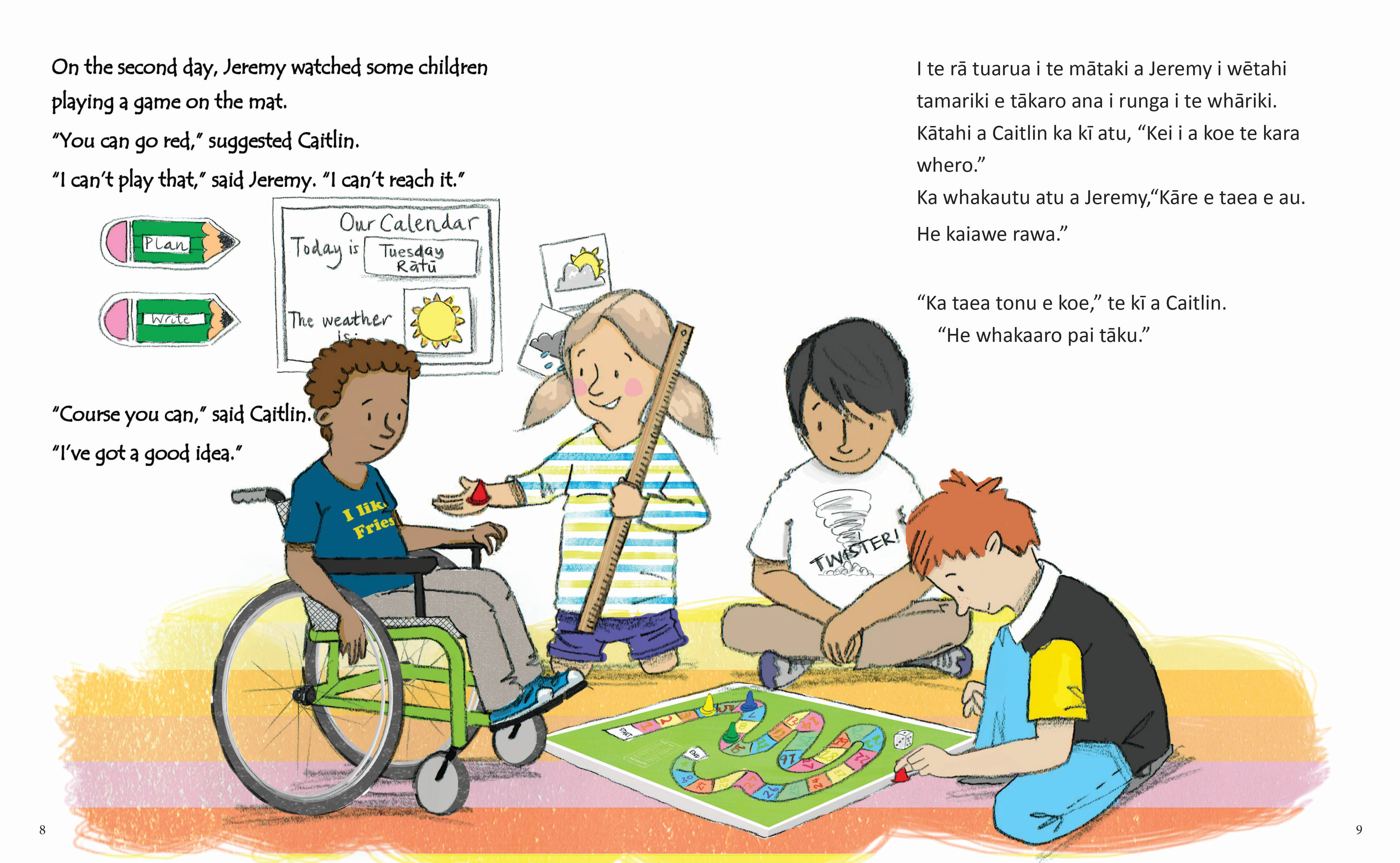
Jeremy uses a wheelchair to get around, and there are definitely some activities that require a different approach for him to take part. But his classmates are undaunted and quickly find the solutions needed in each case.
When his mum asks him each day after school (as mothers do): “How was your day?” his responses gradually grow more positive, from a grunted “All right” to “Fun!” “Great!” and finally an enthusiastic “Awesome!”
He discovers he likes school, that it’s good to be with friends who, like him, enjoy the games and learning the school environment offers. And ultimately he discovers that he too is just as capable a problem-solver as his classmates have shown themselves to be.
That this story is told in 2 languages is SO refreshing. As grandmother to 2 bilingual boys, I often find my mind racing to catch the gist of what they’re telling me. And as with many other people around the country, I’m hanging out for simple and fun ways to engage with the reo to improve my use and understanding. Ngaere Roberts’ expert phrasing and gently expansive vocabulary make me believe that’s achievable. Ka taea e au te ako i te reo Māori. Ka taea tonu e au!
That this story is told in 2 languages is SO refreshing. As grandmother to 2 bilingual boys, I often find my mind racing to catch the gist of what they’re telling me.
Well done to the publishers for guiding and growing the newer talent on show here also; design and layout are faultless.Writer Karen Hinge’s dialogue and descriptions are spot-on. They hit the mark through restraint — there’s so much that doesn’t need to be said – and gentle repetition.
Nicky Sievert employs a range of equally understated illustration techniques and perspectives that move the story along with a good-natured ease, while additional visual narratives around everyday ephemera are to be found quietly humming along in the background. Given that this is her first book, she’s one to watch for the future.
So, “How was the book?” you ask.
“Awesome!” I say.
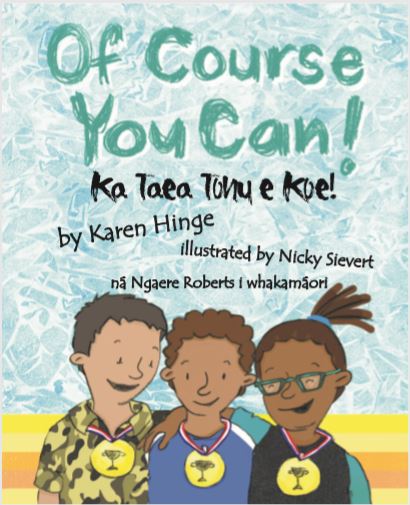
Of Course You Can! Ka Taea Tonu E Koe!
By Karen Hinge
Illustrated by Nicky Sievert
nā Ngaere Roberts ngā kōrero i whakamāori
OneTree House
RRP $17.99
Maiden Voyage, by Jaimee Poipoi, Adam Reynolds & Chaz Harris, illustrated by Christine Luiten & Bo Moore (Promised Land Entertainment)
This is the story of a young woman, Ru, who learns from her father on his death-bed that she is a princess; that her mother whom she barely remembers, just “her ocean-blue eyes”, was also a princess; that her mother might yet be alive and that she should journey to where she, Ru, rightly belongs. So begins her quest. A quest which will take her over the ocean, armed with her father’s sea-belt, a map “for a grand adventure” and her own royal dagger. Along the way, she finds a soul-mate, Freya, whom she learns to trust and love.
Meanwhile the “wicked Queen Neva” learns of Ru’s existence and plots her demise.
If all this sounds a bit far-fetched and convoluted, that’s because it is. That’s the nature of fairy tales. They’re full of eerie mists, dark mountain fortresses, pirates, dungeons and taverns; motifs in the form of magic gems, hidden maps, psychic cats… Maiden Voyage uses these motifs and the form of the fairy tale to show Ru’s quest as part of her becoming, finding her identity and true destiny.
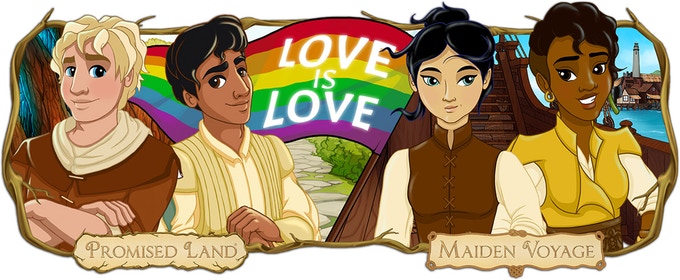
The last century saw the strong commercialization of fairy tales via Walt Disney’s dazzling animations. Stories were scripted to reinforce notions of propriety for that era of white, male, heterosexual dictates. Female characters were beautiful and passive, males daring and courageous. And almost everyone was Caucasian. What these writers and illustrators want to do is stimulate readers to re-think how fairy tales mirror social values and norms. Using the fairy tale form alongside Disneyesque illustrations, they present a cast of characters representative of a wider, more inclusive society.
But fairy tales are also about getting into trouble and the effort it takes to get out of trouble. They’re stories about being powerless and lonely, about old curses and spells that must be broken through random acts of kindness on one hand and completing seemingly impossible or futile tasks on the other. Quite often they make no sense, but they capture our imagination and in the telling we find we need to follow them, and follow and follow…
Quite often they make no sense, but they capture our imagination and in the telling we find we need to follow them, and follow and follow…
I question whether these story creators have made the right choice of genre for this to truly happen here. Fairy tales necessarily employ a wide range of characters and settings to navigate complex story-arcs and sub-plots; they require space for the telling, space that the genre of the traditional picture book doesn’t offer. Picture books often work best with short, simple plots – no sub-plots – generally with one main character and viewpoint, and when the illustrations develop the storyline just as succinctly.
By shoehorning this tale into a tight, standard picture book framework, the creators have done a disservice to the story itself. Sub-plots and back-stories take the reader by surprise: my 7-year-old co-reader was befuddled on more than one occasion when both setting and characters changed abruptly, without the meanwhile-back-at-the-ranch alert that more space would have allowed. Overall it feels like the story has been radically condensed, and as a consequence has compromised the sense of enchantment any fairy tale worth its salt depends upon.
While the creators have poured admirable effort into ensuring a quality production, it tells a truncated tale that stops short of the magic required.

Maiden voyage
By Jaimee Poipoi, Adam Reynolds & Chaz Harris
Illustrated by Christine Luiten & Bo Moore
Promised Land Entertainment
RRP $20
Annemarie Florian
Annemarie Florian has spent the whole of her adult life in the company of children’s books — as bookseller and book awards judge, as curriculum designer and librarian, as parent and grandparent, reader, reviewer and writer. She is particularly interested in how books and language can influence who we are and how we view ourselves, as individuals and as a community.



